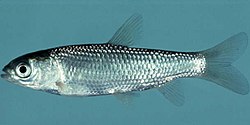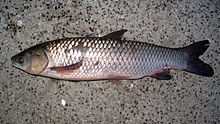Grass carp: Difference between revisions
→Appearance and anatomy: + photo |
Jboltonnal (talk | contribs) |
||
| Line 57: | Line 57: | ||
==External links== |
==External links== |
||
{{commonscat|Ctenopharyngodon idella}} |
{{commonscat|Ctenopharyngodon idella}} |
||
* [http://www.invasivespeciesinfo.gov/aquatics/asiancarp.shtml Species Profile- Grass Carp (Asian Carp) (''Ctenopharyngodon idella'')], National Invasive Species Information Center, [[United States National Agricultural Library]]. Lists general information and resources for Grass Carp. |
|||
*{{FishBase valid species list|Ctenopharyngodon}} |
*{{FishBase valid species list|Ctenopharyngodon}} |
||
* {{ITIS |id=163537 |taxon=Ctenopharyngodon idella |accessdate=11 March 2006}} |
* {{ITIS |id=163537 |taxon=Ctenopharyngodon idella |accessdate=11 March 2006}} |
||
Revision as of 20:13, 9 February 2011
| Grass Carp | |
|---|---|

| |
| Juvenile Grass Carp | |
| Scientific classification | |
| Kingdom: | |
| Phylum: | |
| Class: | |
| Order: | |
| Family: | |
| Subfamily: | |
| Genus: | Ctenopharyngodon Steindachner, 1866
|
| Species: | C. idella
|
| Binomial name | |
| Ctenopharyngodon idella (Valenciennes in Cuvier & Valenciennes, 1844)
| |
The Grass Carp (Ctenopharyngodon idella) is a herbivorous, freshwater fish species of family Cyprinidae, and the only species of the genus Ctenopharyngodon. It is cultivated in China for food but was introduced in Europe and the United States for aquatic weed control (see, e.g., Ponchatoula Creek). It is a large cyprind native to Eastern Asia, with a native range from Northern Vietnam to the Amur River on the Siberia-China border.[1] It is a fish of large, turbid rivers and associated floodplain lakes, with a wide degree of temperature tolerance. Grass carp are usually thought to enter reproductive condition and spawn at temperatures of 20 to 30 °C (68 to 86 °F),[2] but have been shown to sometimes spawn at temperatures as low as 15 °C (59 °F).[3]
In the United States, the fish is also known as White Amur, a name developed to avoid use of the name "carp", which has derogatory connotations in North America. The name derives from the Amur River, where the species is probably native, but has never been abundant[4] This is not to be confused with the White Amur Bream (Parabramis pekinensis) which is not a particularly close relative as Cyprinidae go.
The fish are eaten and may be steamed, pan fried, broiled, or baked.[5]
Appearance and anatomy



White amur have an elongate, chubby body form that is torpedo shaped. The terminal mouth is slightly oblique with non-fleshy, firm lips, and no barbels.[6] The complete lateral line contains 40 to 42 scales. Broad, ridged pharyngeal teeth are arranged in a 2, 4-4, 2 formula. The dorsal fin has 8 to 10 soft rays, and the anal fin is set closer to the tail than most cyprinids. Body color is dark olive, shading to brownish-yellow on the sides with a white belly and large slightly outlined scales.
The grass carp grows very rapidly, and young fish stocked in the spring at 20 centimetres (7.9 in) will reach over 45 centimetres (18 in) by fall, and adults often attain nearly 1.2 metres (3.9 ft) in length and over 18 kilograms (40 lb) in weight. According to one study, they live an average of 5-9 years with the oldest gaining 11 years. [7] They eat up to 3 times their own body weight daily. They thrive in small lakes and backwaters that provide an abundant supply of fresh water vegetation.[citation needed]
Ecology
This species occurs in lakes, ponds, pools and backwaters of large rivers, preferring large, slow-flowing or standing water bodies with vegetation.[8] In the wild, grass carp spawn in fast-moving rivers, and their eggs, which are slightly heavier than water, develop while drifting downstream, kept in suspension by turbulence. The eggs are thought to die if they sink to the bottom.[9]
Adults of the species feed primarily on aquatic plants. They feed on higher aquatic plants and submerged terrestrial vegetation, but may also take detritus, insects, and other invertebrates.[10][5]
Invasive species
The species was deliberately introduced into the United States in 1963 for aquatic weed control. It was introduced into New Zealand along with stocks of goldfish but the distribution is carefully controlled to prevent it from becoming a more widespread pest.
The Grass Carp is considered an invasive species in the United States,[11] however it is still stocked in many states as an effective biocontrol for undesirable aquatic vegetation, many species of which are themselves invasive. Grass carp require long rivers for the survival of the eggs and very young fish, but they have become very abundant in the large rivers of the central United States. Grass carp effects on their invaded environments are quite variable, with both desirable and undesirable effects.[12]
Use as weed control
The species was introduced in the Netherlands in 1973 for aquatic weed control against overabundant weed growth. The release of grass carp into national waters is controlled and regulated by the Dutch Ministry of Agriculture, Nature and Foodquality. Because grass carp mainly reproduce in water of 25 °C (77 °F), which is much higher than the water temperature reaches during the mating season in the Netherlands, it is necessary to maintain grass carp populations by artificial means, which is done by the person responsible for the water body in which the fish were introduced. Where grass carp populations are maintained through stocking as a biocontrol for noxious weeds, they should be returned into the water alive and unharmed.
When used for weed control, often the fish introduced to the pond or stream are sterile, triploid fish. The process for producing triploid fish involves shocking eggs with rapid change in temperature or pressure. This process is not usually 100% effective, therefore, in the United States, the young are usually tested for triploidy before being sold.[13] Bait often consists of vegetables or fruits that are native to the area.[14]
Fishing for grass carp
Grass carp grow large and are strong fighters on a rod and reel, but because of their vegetarian habits and their wariness, they can be difficult to catch.[15] Chumming with corn adds to success. Canned corn, cherry tomatoes, and, despite their primarily vegetarian habits, worms can sometimes be successful baits. They are popular, but wary, quarry for bowfishers where bowfishing for grass carp is legal.
References
- ^ Mandrak and Cudmore. 2004. Biological Synopsis of Grass Carp (Ctenopharyngodon idella) http://sbisrvntweb.uqac.ca/archivage/24061712.pdf.
- ^ Mandrak and Cudmore. 2004. Biological Synopsis of Grass Carp (Ctenopharyngodon idella) http://sbisrvntweb.uqac.ca/archivage/24061712.pdf.
- ^ Shireman, J.V. and C.R. Smith. 1983. Synopsis of biological data on the grass carp, Ctenopharyngodon idella (Cuvier and Valenciennes, 1844). Food and Aquaculture Organization Synopsis. 135: 86pp.
- ^ Mandrak and Cudmore. 2004. Biological Synopsis of Grass Carp (Ctenopharyngodon idella) http://sbisrvntweb.uqac.ca/archivage/24061712.pdf.
- ^ a b Froese, Rainer; Pauly, Daniel (eds.). "Ctenopharyngodon idella". FishBase. May 2007 version.
- ^ www.fishbase.org
- ^ Kirk and Socha. J. Aquat. Plant Manage. 41:2003. http://www.apms.org/japm/vol41/v41p90.pdf
- ^ www.fishbase.org
- ^ Krykhtin, M.L., and E.I. Gorbach. 1981. Reproductive ecology of the grass carp, Ctenopharyngodon idella, and the silver carp, Hypophthalmichthys molitrix, in the Amur Basin. Journal of Ichthyology 21(2):109-123.
- ^ Mandrak and Cudmore. 2004. Biological Synopsis of Grass Carp (Ctenopharyngodon idella) http://sbisrvntweb.uqac.ca/archivage/24061712.pdf.
- ^ Management and Control Plan for Bighead, Black, Grass, and Silver Carps in the United States http://www.anstaskforce.gov/Documents/Carps_Management_Plan.pdf
- ^ http://nas.er.usgs.gov/queries/FactSheet.asp?speciesID=514
- ^ Management and Control Plan for Bighead, Black, Grass, and Silver Carps in the United States http://www.anstaskforce.gov/Documents/Carps_Management_Plan.pdf
- ^ "Triploid Grass Carp in New York Ponds". New York State Department of Environmental Conservation.
- ^ Catching Grass Carp, Missouri Department of Conservation http://mdc4.mdc.mo.gov/Documents/18513.pdf
External links
- Species Profile- Grass Carp (Asian Carp) (Ctenopharyngodon idella), National Invasive Species Information Center, United States National Agricultural Library. Lists general information and resources for Grass Carp.
- Valid species list of genus Ctenopharyngodon on FishBase.
- "Ctenopharyngodon idella". Integrated Taxonomic Information System. Retrieved 11 March 2006.



